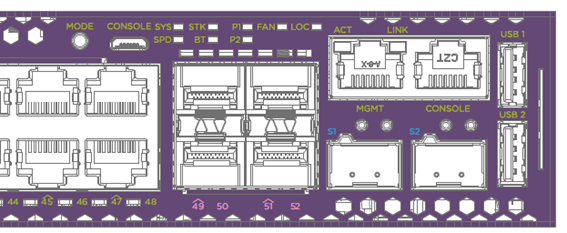5420 Series Switch LEDs
ExtremeSwitching 5420 Series front panel port LEDs, as described in the following table:
|
LED |
Color/State |
Port State |
|---|---|---|
|
SYStem status LED (Legacy MGMT function) Note: The system
status LED is solid green to indicate normal operation when the
switch is running Fabric Engine.
|
Green flash slowly |
POST Passed, normal operation, blinks on standalone switch, stack primary, and backup nodes in a stack; off for standby nodes in a stack |
|
Green blinking |
POST in progress |
|
|
Amber blinking |
POST failed or overheat |
|
|
PSU status LEDs P1/P2 |
Green |
Power On |
|
Off |
Power off and no power attached |
|
|
Amber Blinking |
Power supply failures |
|
| Speed status (SPD), Stacking status (STK) | SPD solid green | Speed mode |
| STK solid green | Stacking mode | |
| All off | Normal mode | |
|
Fan status for 5420F |
Green |
Normal operation |
|
Amber Blinking |
Fan failure |
|
| Fan module status for 5420M |
Green |
Normal operation |
|
Amber Blinking |
Fan module failure |
|
|
Off |
Fan module not present |
|
|
Bluetooth Status LED (BT) |
Green Blinking |
Bluetooth pairing in progress |
|
Green |
Bluetooth connected |
|
| Off |
Bluetooth not connected |
|
|
Locator LED (LOC) |
Blue Blinking |
Locator function |
The following figure shows the two alternate mode LEDs for 5420 Series switches: SPD and STK. The Mode button is used to cycle through three display modes for the port LEDs. In the default mode, SPD and STK are off. SPD and STK display modes expire after 30 seconds, at which time the port LEDs revert to the default SYS mode. Pressing and holding the the Mode button initiates Bluetooth pairing.


Note
Front-panel PoE ports use Amber to indicate PoE states.
Port LEDs in Default (SYS) Mode
In the default SYS mode, SPD is OFF, and the port status displays behavior for link, traffic, and PoE as described in the following table:
|
Color/State |
Meaning |
|---|---|
|
Green |
Link is OK; port is not powered |
|
Amber |
Link is OK; port is powered; no traffic |
|
Green blinking |
Link is OK and transmitting packets; port is not powered |
|
Amber blinking |
Link is OK and transmitting packets; port is powered |
|
Amber slow blinking |
No link, or disabled port; port is powered |
|
Alternating amber and green |
Port has a power fault |
|
Off |
Port is not powered, has no link, or is disabled |
Port LEDs in SPD Mode
The port LEDs enter the SPD display mode when the Mode button is pressed one time, indicated by the SPD LED. SPD mode is used to help determine the operational speed of a port.
There are two LEDs per SFP-DD port on 5420 models. When an SFP-DD port is used for Ethernet and stacking is disabled, each SFP-DD port can be used as either a single SFP+ port or two SFP+ ports if an SFP-DD transceiver is used on 5420M models. When the SFP-DD port is used for as a single SFP+ port, the first LED represents link and traffic, while the second LED is not operational. When the SFP-dd port is used as two SFP+ ports, the first LED represents link and traffic for the first port, and the second LED represents link and traffic for the second port. 5420F models are limited to one 10Gbps port per SFP-DD port in Ethernet mode with stacking disabled. The second SFP+ port is not available and the second LED is not operational.
In stack mode, each SFP-DD port can be used as one 20Gbps SFP+ port, or one 10Gbps SFP+ port, depending on the stack speed and optic used. The first LED represents the link state and traffic of the stack port with solid or blinking green. The second SFP+ port is not available and the second LED is not operational.
Color and blink pattern indicate speeds, as referenced by the following table:
|
Color/State |
Speed |
|---|---|
|
Green |
10Mbps |
|
Green blinking |
100Mbps |
| Amber |
1000Mbps |
|
Amber slow blinking |
2.5Gbps |
|
Green slow blinking |
10Gbps |
|
Green fast blinking |
25Gbps |
|
Green fast blinking |
40/50Gbps |
Port LEDs in STK Mode
The port LEDs enter the STK display mode after the Mode button is pressed twice, indicated by the STK LED. STK mode is used to indicate slot presence and slot number via the first eight port LED, as referenced by the following table:
|
Color/State |
Speed |
|---|---|
|
Green |
The slot corresponding to the port number of the LED is present. |
|
Green blinking |
This slot has a slot number corresponding to the port number of the blinking LED. |
Management Port LEDs
The management port uses two LEDs to indicate port activity and link status, as referenced by the following table:
| Right side LED | State | |
|---|---|---|
| Link | Green | Link up |
| Off | No link up or port disabled | |
| Left side LED | State | |
| Act | Green blinking | Packet transmitting or receiving |
| Off | No packet transmitting or receiving | |

